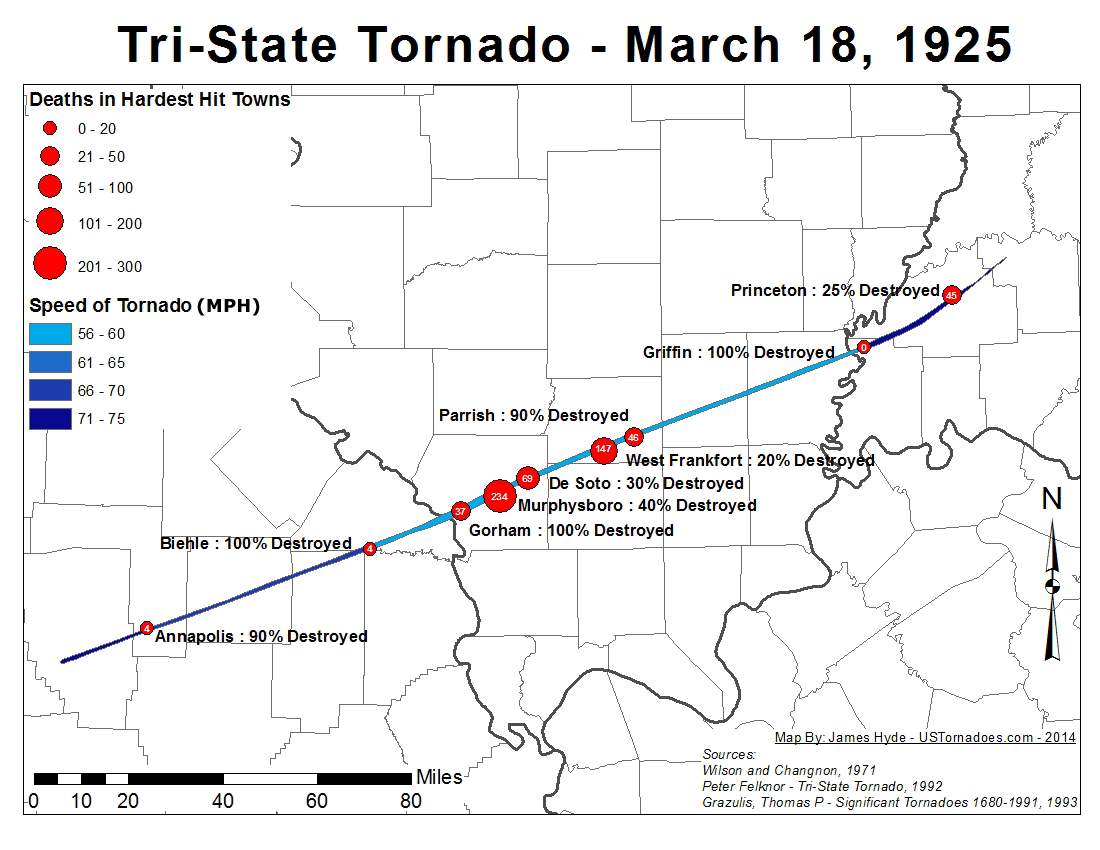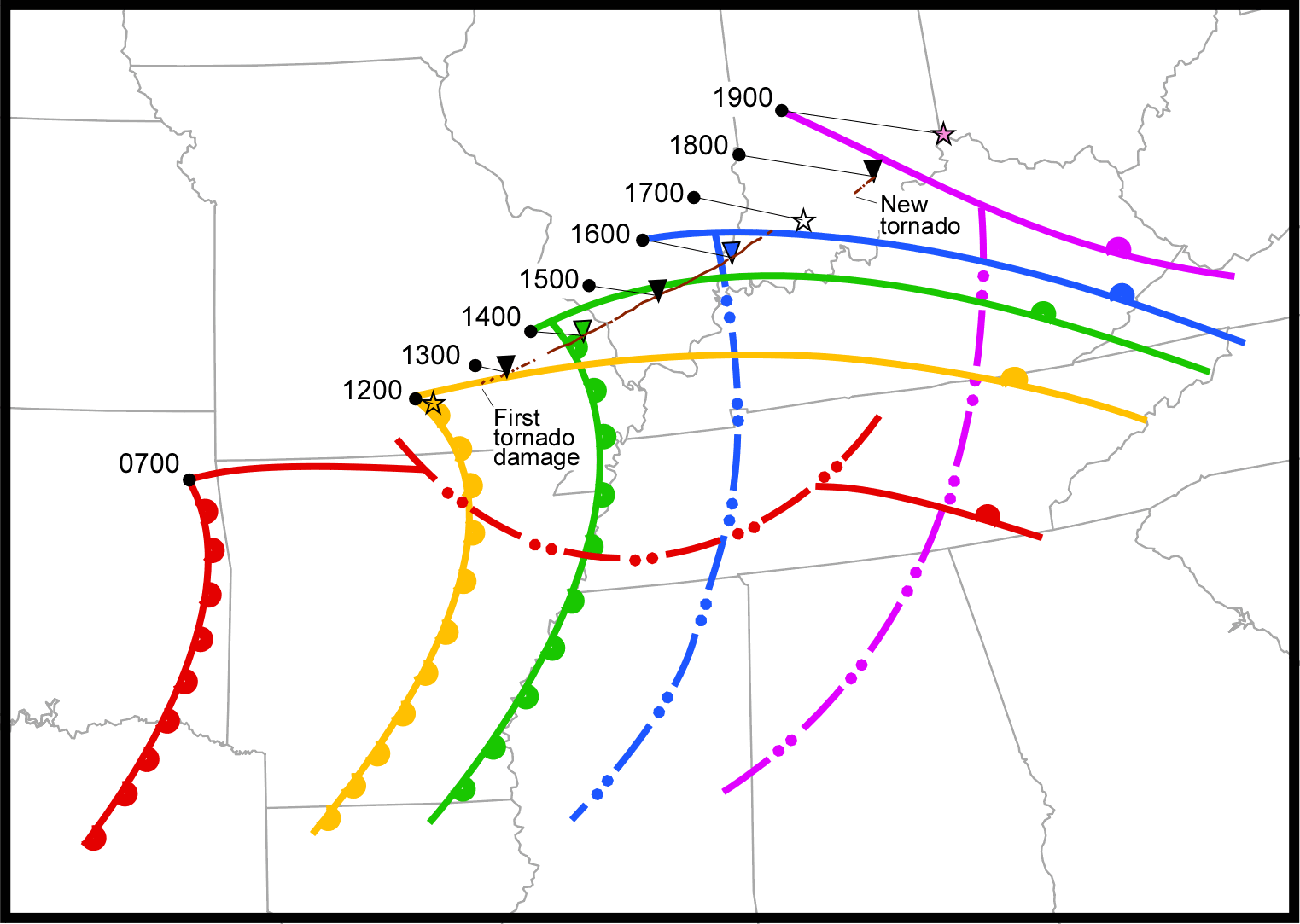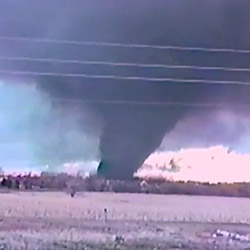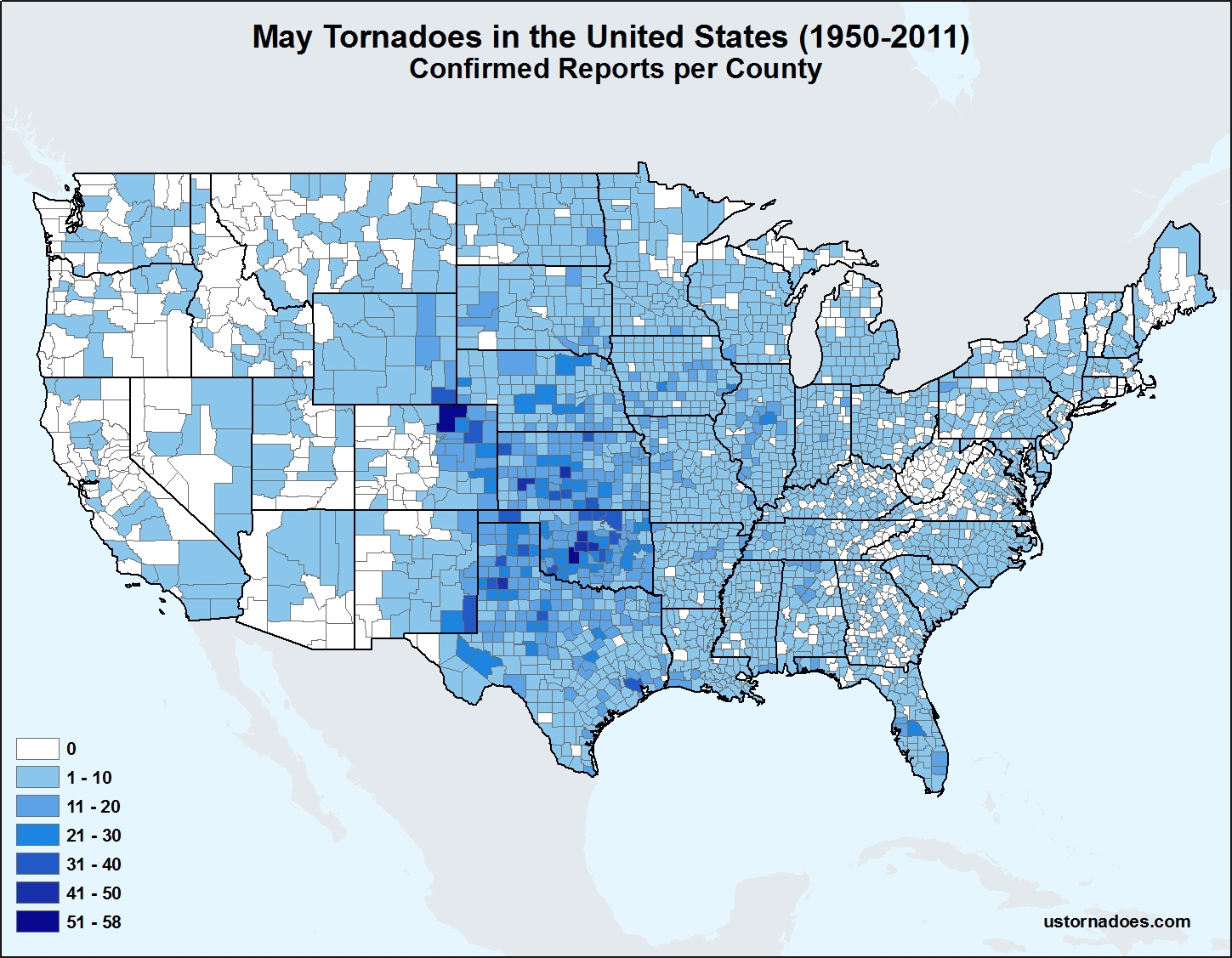On March 18, 1925 a dark “smokey fog” touched down approximately three miles northwest of Ellington, Missouri. It would become known as the Tri-State Tornado. By all accounts the Tri-State Tornado was one for the record books.
The Tri-State Tornado is currently the U.S. record holder for longest tornado track (219 miles), most deaths in a single tornado (695), and most injuries in a single tornado (2027). While it occurred before the modern record, it is considered by all accounts to be a F5/EF5 Tornado. It crossed the three states, thus it’s namesake “Tri-State,” tearing through thirteen counties of Missouri, Illinois, Indiana. It crossed over and destroyed or significantly damaged nine towns and numerous smaller villages.
The track of this tornado has been lost to the 89 years of growth of vegetation and development by humans. One map, done by Wilson and Changnon in 1971, seems to provide the most accurate path of this tornado. However, in searching for an electronic or digitized copy of this map I could not find one. I decided to re-create their map in geographic software as seen below.

The resulting map perhaps shows why this tornado was so deadly. First off was the speed of the tornado. The average speed across it’s life span was an astonishing 62 miles per hour, with forward speeds at times reaching 73 mph. Also worth noting is that the tornado followed a slight topographical ridge with a series of mining towns perfectly aligned the path. Despite the staggering death toll and thousands of injuries, the stories that have emerged from the are quite astonishing. Using the map above, we can see where some of these stories came from.
In Annapolis, Mo., the day was quite hazy with just a few thunderclaps in the distance, then at 1:30 p.m. the “smokey fog” came down from above the small Ozark hills town. It came and left so quickly that nobody knew what had really happened. The only logical explanation was a twister of some sort. 90 percent of the town was destroyed. When the tornado approached the town of Beihle, Mo. a double tornado was reported along a three mile stretch. It is unclear whether this phenomenon was a satellite tornado around a parent tornado, or if the old tornado was dying and a new one forming. Regardless, the damage path went on.
Crossing the Mississippi river, the tornado then struck the town of Gorham, Il. Gorham was a town of about 500 people and of those 500, 37 were killed and 250 injured. One notable effect in Gorham was the grass being torn from the ground in a gully on the east of town. The next town was Murphysboro. Eugene Porter reported the tornado to be “about a mile wide”. The town of Murphysboro suffered heavy losses, with 234 casualties reported along with 623 injuries. About 100 square blocks of the town were destroyed along, with another 70 by a fire after the tornado.
Perhaps the most astonishing show of power came from the next town in line, DeSoto, Il. Trees were snapped off at knee height and stumps then ripped out of the ground. No structure was left standing in the tornado’s path. Of the 69 people killed in DeSoto, 33 were killed in a school.
Next up, West Frankfort was a mining town, and as such most of the men worked in the mines. When the electricity went out, the miners went to the surface to see what the problem was. The miners came to the surface of a destroyed landscape. Most of the 148 deaths and 400 injuries in West Frankfort were women and children given the men were in the mine.
A man in Parrish, Il. survived the tornado by clinging to a railroad track while the town was destroyed. 46 people died and at least 100 were injured here. Between Gorham and Parrish, 541 lives were taken.
The tornado continued northeast, and over the next hour mostly farms and an occasional school house or general store were destroyed. Once into Indiana, the town of Griffin was destroyed, followed by the south side of Princeton.
In Princeton, residents saw a “blackness” move across the south side of town, no one in north Princeton knew or even guessed that the other southern half of the town had been destroyed until injuries and bodies started showing at the hospital. 45 people were killed and 152 injured there. The tornado then weakened and dissipated as it took a more northeasterly direction, finally dissipating just southwest of the town of Petersburg, In.
Total time on the ground of the Tri-State tornado was 3 hours and 30 minutes. During that time, it traveled 219 miles and killed 695 people. Most of them in Illinois.
The meteorological conditions surrounding the tornado are also just as interesting as the tornado itself. The residences in the fully destroyed town of Gorham, Illinois recalled the morning being rainy and drizzly, with dark and gloomy skies and little wind. For anybody who follows severe weather, this is seen as an oddity. Often, areas that see tornadoes are at least partly sunny and windy in the morning, as moist air runs along the surface and the sunshine heats it, only to be exploded into massive thunderheads in the afternoon.
Robert Maddox, et al. did a fantastic analysis of the meteorological conditions on the day of the tornado (full report). What they found was that the tornado ran along what is called the triple point, the intersection between the warm front, cold front, and occluded front, near the center of low pressure. The image below from their report shows the position of the tornado relative to the surface features.

Ending on a more lighthearted note, there are many fascinating stories that came from this tornado. Here are just a few, taken from Peter S. Felknor’s Book, Tri-State Tornado:
- In West Frankfort, Il. a farmer found a barber chair from some other town, and a bond — that was in a safe to begin with — was found 125 miles away and later mailed back. A house was also left standing while the trees surrounding it were cut off at the trunk or uprooted.
- A man in Griffin, IN reported that he grabbed a door-handle and the house blew away, leaving the door handle with him.
- A popcorn man in Murphysboro, Il. was reportedly tossed up in the air “to the height of a one story building” then set back down a block away. His popcorn stand moved three feet and was still on it’s wheels.
Sources:
Illinois Tornadoes ; Wilson and Changnon, (1971)
Tri-State Tornado, Peter S. Felknor, (1992)
Grazulis, Thomas P – Significant Tornadoes 1680-1991, (1993)
Meteorological Analyses of the Tri-State Tornado Event of March 1925, Maddox et. al , (2013)
Further Reading:
Storm-Stalker, The Tri-State Tornado, 2013 (lots of good pictures of damage)
Detailed information from NWS Paducah
James Hyde
Latest posts by James Hyde (see all)
- The Natchez, Mississippi tornado of 1840 - May 7, 2017
- Understanding advanced tornadic radar signatures - March 28, 2017
- Breaking down the Pilger tornadoes of June 16, 2014 - July 16, 2014


Interesting that there’s no evidence of a cycloidal curve in the damage path. Typically with long-track tornadoes, there’s some curve of the path as the tornado is caught up in the circulation around the parent mesocyclone.
From what I could piece together, the path wasn’t quite as straight as it looks. There were some slight wobbles between Murphysboro and West Frankfort, again between there and the Wabash River, and then a modest recurve between the river and the point where it dissipated northwest of Petersburg. Pretty typical for what was essentially a steady-state supercell.
I’m making a report for this tornado 🌪️. My mother said to me, that she watches a large tornado 🌪️ pass through the front of the dairy pasture at their place at Cunot, Indiana. I have photos of this damage showing how the plumbing was present, but bent in all angles, and the barn atop was gone. This at Cunot, Indiana. Her family had moved to Cunot, Indiana in 1921 from the dairy at Broad Ripple,. Marion County, Washington Twsp. Interesting that the path stops at the west some miles but this damage is present in Owen Co. Thanks for your time. Good to get with you some. John McShanog Jr. Indianapolis, Indiana June 24 th, 2021
Hi David,
Early on in this tornado’s life while in the Ozarks of Missoui, there is some evidence to suspect that there was at least a few occlusions and reformation of the tornado. One such instance is the Beihle report of a double tornado. The damage has been lost to time but it was said the damage path was continuous. However, it is uncertain (and likely will forever stay that way) whether that damage was purely from the tornado or from RFD winds. Like Shawn said above, once into Illinois, the damage path was continuous but it did have wobbles. It would have been considered today as a long track “grinder” much like those that struck during the 1974 or the 2011 outbreaks.
Thanks for reading,
James
Thanks for linking to my blog, James, I enjoyed your post. I’ve always found it a bit ironic that the most extraordinary tornado in American history formed on a day that, on first glance, hardly suggests much tornado potential. This event actually shares several similarities with the 1947 Glazier-Higgins-Woodward tornado. Both days started off cool, cloudy and rainy, followed by a tremendous surge of moisture in a fairly short time period, and both were the result of a supercell forming in an ideal position at the triple point and moving along or just on the cool side of the warm front, where helicity was maximized.
Also, it understandably always gets overshadowed by the Tri-State tornado, but there was also a significant tornado outbreak further south across Kentucky and Tennessee. Several supercells initiated along the dryline and produced extremely violent tornadoes.
Cool site, somehow had not seen it myself.. bookmarked for future reading! Thanks for the extra info as well. Also, great avatar!
My grandfather, Herbert Smith, was in the Illinois State National Guard (he was also a Great War veteran) and helped in the rescue an clean up in Murphysboro, Ill. after this disaster. He never spoke of it, but for the rest of his life, he could not sleep during storms at night. He would just wander silently about the house he lived in, occasionally looking out of the windows …
The Paducah NWS link is no longer pointing to their archive of Tri-State Tornado History. I’m hoping they know what’s up, and resurrect it. Thanks for this great article though, and the link to Shawn’s blog. I’m going to point my students to it.
this is very helpful. thank you
I had to use this for a project for school. gave me an A+.
This is my first time to see this site and it’s giving me a lot of information about the subject for my Natural Disasters project
And it was very helpful, thank you James for the imformation
My mother, Vernice E. Criley, was seven years old when the tornado hit Parrish, Illinois. All relatives on her mother’s side were killed. Her grandmother (Louella E. Galloway nee Dillon), grandfather (Frankfort K Galloway), aunt (Beulah Price nee Galloway) , two uncles (Royal Eugene Galloway and Layman Price) and a baby cousin (Jackie Jean Price, 19 days old.) Her mother, Edna Criley nee Galloway, had died two years earlier. My mother was in her grandmother’s house when the tornado struck. She had both hips broken and several holes punched in her head. She was found in a creek bed, wrapped in the arms of her dead grandmother. She received little medical attention for several weeks and her broken hips begun to knit. Subsequently, she had to have several surgeries to reconstruct balls and sockets in both hips. Mind you, this was 1925!! She fully recovered and walked straight and true, with no arthritis pain, until hobbled by a stroke in 1998. One more note. In the front yard of her grandparent’s house was a big tree her grandmother wanted taken down because it was ‘dangerous.’ After the tornado, the tree was still there, but the house was gone.
this is a realy cool web site its helping me with my project
I am so sad about this tragedy millions of people died but it is helping me with my project so thank you for that but i have one question how long did it last before it died out?
Hi there Bella, I’m glad that the article helped you with your project. Just to clarify. 695 people died and it lasted approximately 3 hours and 30 minutes.
My father was a teenager when this happened. They lived on a farm in St.Francois County. I remember him telling me that debri from this storm landed on the farm. Witnessing the cloud would have been hard to do as there were large hills to the South. In Missouri a storm can be on top of you before you know it if you live in the hilly southern section. Dad was not afraid of much of anything but her was scared to death of tornadoes. A week before he passed away in 1997 a severe storm passed close to his home. He had severe Alzheimer’s and was bedridden. In spite of all this he rose up from bed and announced that it was “Time to go to the cellar.” He then walked without assistance to the basement door. What amazes me about this was his knees were frozen due to severe arthritis.
Thanks for this blog! Really helped me with my school project. Plus, it was very interesting.
This was very helpful for my SOSE assignment. Thanks you so much. Does anyone know what responses occurred after the disaster? Primary, secondary and tertiary responses? Any imformati0on is helpful thanks, Aidan.
it was easy for my forces of nature class
My great great aunt and her sister survived that tornado in southern Indiana. She and her sister survived but their mother did not. She told me she was about 3 or 4 at the time and can still remember it all to this day.
I liked this source i am using it for my school project
Another oddity in Murphysboro, my mother Agnes Marie Bean told of their canary sitting atop the piano in a cage, along with a $10.00 bill…house destroyed but bird & bill intact.
Thank you so much for this blog! It helped me really much on my project in school. I learned so much about the Tri state Tornado and now I’m being really interested in tornadoes. So thank you so much, James. It was sad that there were so many that died, but it made history. The Tri state Tornado has many records in the US history. Just a question, wasn’t it 3 hours and 45 minutes? Because that was what I thought. Anyways, I will be on this site way more. It helped me really much just with this.
Very interesting information. A tornado occurred last nite, 12/10/2021 that hit 4 states and may have had a longer path than that of the Tri State Tornado. No doubt the monetary loss will be much higher than the Tri State Tornado and the Fatalities are still unknown at this time but I can’t help but believe that the fatalities will be very high because this tornado struck in the night.